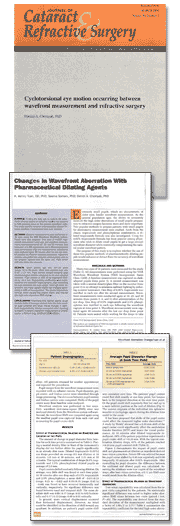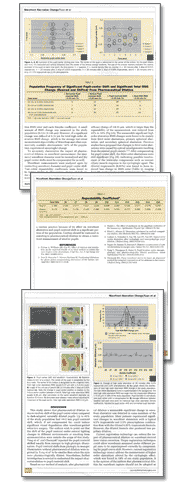Peer Reviewed Articles
Scientific Credibility is Built on Publishing in the Peer Reviewed Literature
Peer reviewed journal articles should be an important part of any technology company’s communications strategy. A foundation of peer reviewed articles in the Literature establishes a serious reputation in a way that no other kind of publication can. Publication of research in the Literature imparts credibility that translates to increased sales, higher share price, more likely reimbursement for customers, and for new companies, powerful persuasion for venture funding.
- Peer review builds on and strengthens a company’s scientific reputation.
- Peer review lasts forever. Articles will be read, searched, and cited for years and even decades.
- Peer review documents the medical evidence that payers require for reimbursement.
- Peer review provides a solid basis for marketing claims.
- Peer review publication lends prestige to a company and helps attract and retain talent. Top researchers want to publish.
Peer Reviewed Publication List
- Anne L, Hu M, Chan K, Colin L, Gottwald K. Potential problem with fluorescence polarization immunoassay cross-reactivity to vancomycin degradation product CDP-1: its detection in sera of renally impaired patients. Ther Drug Monit. 1989;11:585–91
- Bille J, Harner C, Loesel Frieder (Eds.). Aberration-Free Refractive Surgery. Second Enlarged Edition .Berlin, Heidelberg, New York. Springer Verlag. 2004
- Chernyak D, Campbell C. System for the design, manufacture, and testing of custom lenses with known amounts of high-order aberrations. J Opt Soc Am A. 2003; 20:2016–21.
- Chernyak D. From wavefront device to laser: an alignment method for complete registration of the ablation to the cornea. J Refract Surg. 2005; 21:463–68
- Chernyak D. Iris-based Cyclotorsional image alignment method for wavefront registration. TBME. 2005; 52:2032–40
- Dai G, Gross E, Liang J. System performance evaluation of refractive surgical lasers: a mathematical approach. Appl Opt. 2006; 45:2124–34
- Dai G, Majahan N. Non-recursive determination of orthonormal polynomials with matrix formulation. Opt Lett. 2007; 32:74–6
- Dai G, Majahan N. Zernike annular polynomials and atmospheric turbulence. J Opt Soc Am A. 2007; 24:139–55.
- Dai G, Majahan V. Orthonormal polynomials in wavefront analysis, error analysis. Appl Opt. 2008; 47:3453–45
- Dai G. Comparison of wavefront reconstructions with Zernike polynomials and Fourier transforms. J Refract Surg. 2006; 22:943–48
- Dai G. Optical surface optimization for the correction of presbyopia. Appl Opt. 2006; 45:4184–95
- Dai G. Scaling Zernike expansion coefficients to smaller pupil sizes: a simpler formula. J Opt Soc Am A. 2006; 23:539–43
- Dai G. Using wavefront measurements to predict visual acuity. Proceedings of SPIE. 2004; 5314:220–28
- Dai G. Wavefront expansion basis functions and their relationships. J Opt Soc Am A. 2006; 1657–68
- Dai G. Wavefront reconstruction from slope data within pupils of arbitrary shapes using iterative Fourier transform. Open Opt J. 2007; 1:1–3
- Dai G. Zernike aberration coefficients transformed to and from Fourier series coefficients for wavefront representation. Opt Lett. 2006; 4: 501–503
- Hu M, Anne L, Forni T, Gottwald K. Measurement of vancomycin in renally impaired patient samples using a new high-performance liquid chromatography method with vitamin B12 internal standard: comparison of high performance liquid chromatography, EMIT, and fluorescence polarization methods. Ther Drug Monit. 1990;12:562–69
- Munnerlyn C, Arnoldussen M, Munnerlyn A, Logan B. Theory concerning the ablation of corneal tissue with large-area, 193 nm excimer laser beams. J Biomed Opt. 2006; 11: 064032
- Munnerlyn C. Lasers in ophthalmology: past, present, and future. J Mod Optics. 2003; 50:2351–60
- Piers P, Manzanera S, Prieto P, Gorceix N, Artal P. Use of adaptive optics to determine the optimal ocular spherical aberration. J Cataract Refract Surg. 2007; 33: 1721-26
- Somani S, Tuan K, Chernyak D. Corneal asphericity and retinal image quality: a case study and simulations. J Refract Surg. 2004. 20:5581–85
- Somani S, Zickler L, Gross E, Cheng L. Shack-Hartmann-based wavefront analyzer for calibrating excimer lasers. J Refract Surg. 2006; 22: 1–5
- Terwee T, Weeber H, van der Mooren M, Piers P. Visualization of the retinal image in an eye model with spherical and aspheric, diffractive, and refractive multifocal intraocular lenses. J Refract Surg. 2008; 24:223–32
- Tuan K, Chernyak D, Feldman S. Predicting patients’ night vision complaints with wavefront technology. Am J Ophthalmol. 2006; 141: 1–6
- Tuan K, Chernyak D. Corneal asphericity and visual function after wavefront-guided LASIK. Opt Vis Sci. 2006: 83:605–10
- Tuan K, Somani S, Chernyak D. Changes in wavefront aberration with pharmaceutical dilating agents. J Refract Surg. 2005; 21:S530–34
- Tuan K. Improved contrast sensitivity after wavefront-guided LASIK. J Cataract Refract Surg. 2006; 32:215–20
- Tuan K. Visual experience and patient satisfaction with wavefront-guided laser in situ keratomileusis. J Cataract Refract Surg. 2006; 32:577–83
- Weeber H, Eckert G, Pechhold W, van der Heijde R. Stiffness gradient in the crystalline lens. Graefe’s Arch Clin Exp Ophthalmol 2007; 245:1357–66


